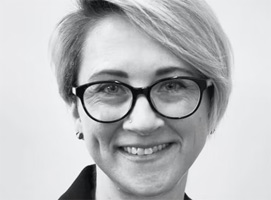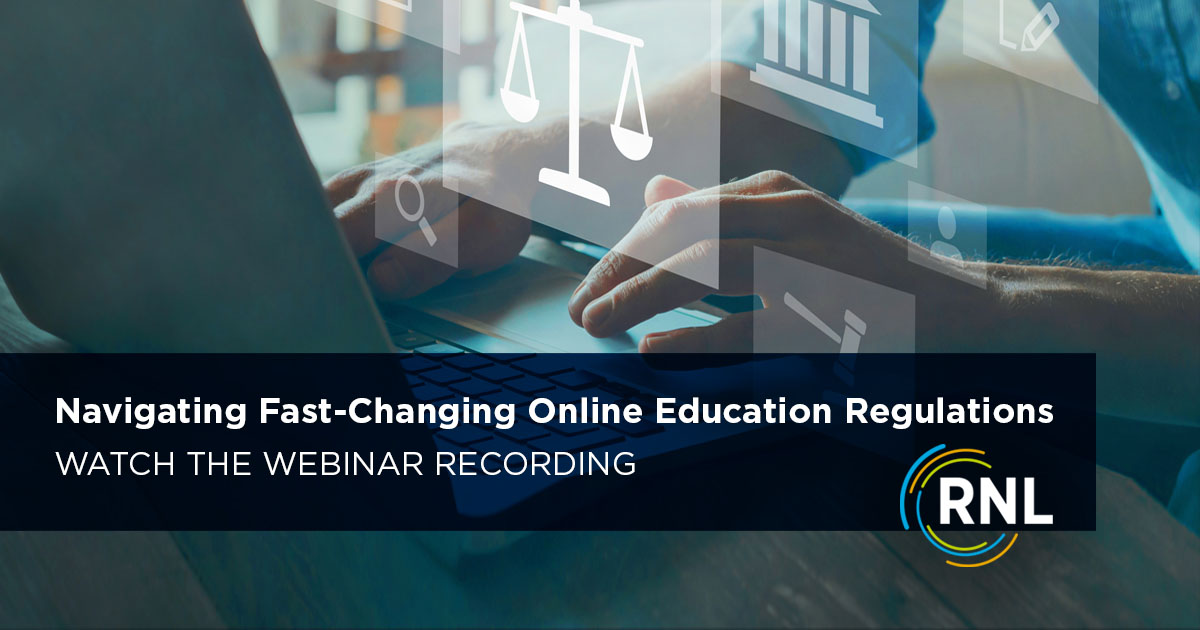enrollment
Managing Rapid Changes in Online Education Regulations
RNL hosted a fascinating webinar with The Century Foundation to explore implications from the new report on the General Accounting Office (GAO) investigation of the relationships between Online Program Management (OPM) companies and their clients. Stephanie Hall from Century joined RNL’s Greg O’Brien for the discussion on how institutions can navigate these online education regulations.
Given Greg’s long background in the higher education industry (he was a founder of Noodle, which was formed at least in part as a response to revenue share OPMs) and Stephanie’s extensive research with Bob Shireman on OPMs, it was bound to be an interesting conversation.
This discussion started with an explanation on just what an “OPM” is, and proceed to discuss why they weren’t such a bad idea 10-12 years ago. From there, Greg and Stephanie talked about what has transpired since then to make them a far less attractive proposition for institutions that want to prepare for the next era of higher education, and what the concerns were that triggered the GAO investigation. Perhaps most interesting was the close, where these two experts opined on what they think the next steps will be by the U.S. Department of Education and other stakeholders. Here’s an excerpt from the webinar:
Here’s a five-minute excerpt from the webinar—click here to watch the entire presentation.
In what follows, we present a summarized transcript of the webinar discussion on navigating online education regulations today:
OUR TWO EXPERTS

Stephanie Hall is a Senior Fellow at The Century Foundation and the author of numerous reports on online program management (OPM) companies. She’s an expert on American and international higher education and teacher education policy. Prior to her work at Century, she worked at the University of Maryland system office in academic and student affairs. She earned her PhD in international education policy at the University of Maryland College Park, and also holds an MA in educational leadership and administration from George Washington University and a BS in middle grades education from Reinhard College.

Greg O’Brien is RNL’s Chief Growth Officer. He is passionate about expanding access to and reducing the cost of quality higher education. And as Chief Growth Officer, Greg collaborates with RNL client partners to help drive successful outcomes for students and their institutions. He also teaches marketing at Harvard University and Southern Methodist University. He was previously the CEO and a co-founder of Noodle, an innovative online program manager. Before Noodle, he was CEO of College Bound and part of the executive team at Quinn Street. Greg has a BS from Cornell University and an MBA from NYU.
What is an OPM? How are arrangements for online programs structured?
Greg O’Brien: The words behind the letters have stayed consistent, but I think over the last five to 10 years, the perception of the market of what the definition is has changed a bit. For decades now companies like Bisk Education and IPD, which is a predecessor to the University of Phoenix, created a business model around helping schools build, grow, and manage an online program whereby those companies would front the upfront capital required to do so to build courses, to do marketing and recruitment. In exchange for that, they would charge a revenue share. Historically (and currently) those revenue shares are more than 50 percent.The duration of the contracts are often today seven to 10 years; historically 10 to 20 years long.
That market has evolved as has the business of online education. But directionally, when we talk about an OPM today, we’re talking about a business doing various parts of what it takes to go and grow online for a university and is doing so in exchange for some meaningful revenue share of tuition dollars.
What is the history of how this OPM business model took hold?
Stephanie Hall: The history dates back to 2010 when the U.S. Department of Education created an exception to the regulation that banned incentive compensation that allowed universities to partner with OPMs and pay them a portion of their tuition dollars—which, by definition, is based on success in recruiting students. This allowed publics and nonprofits to offer online programs and compete with for-profits, who were first out of the gate in the online degree space. In this competitive sense, the exception to the incentive compensation ban really served its purpose.
Today, far more students study online at publics and nonprofits than at for-profits. That is a positive development, at least on the face of it. Programs offered via OPMs by publics and nonprofits are of higher value because (at least on paper) those institutions have name recognition with employers, job candidates may get a bit further than if they had a school on their resume that has previously been caught up in scandal or closed as a result of scandal.
That was a positive development. However, over the last decade some institutions have used that exception to the regulations to put a nonprofit facade on what is essentially a for-profit operation. This is a clear misuses of the Department’s intent, and that has not yet been addressed by the federal government.
I think 12 years into this trajectory, we might expect to see some movement in a new direction. Over the last several years, there is evidence that that intent of the regulatory exception has been exhausted and could be reasonably retracted. It also seems clear that some traditional institutions appear to have become wholly captive to their OPM.
Have the changes/advances in online education in recent years necessitated a change of direction?
Greg O’Brien: Fifteen years ago, online was something done by for-profit schools and otherwise an experimental/incremental thing done by privates and publics. As an experiment, different commercial models that relinquished most of the economic gains through a revenue share were likely a smart way of reducing risk and potential financial loss. But in the last several years, online has become an integral part of how most modern universities deliver a big part of their education. The year before the pandemic, 31 percent of graduate degrees conferred in the US were conferred to people who had completed their degree entirely online. That’s no longer an experiment.
Online education is growing by 12 to 15 percent each year now. We’re not too far from having half of graduate education in America being entirely online and undergraduate is catching up, with about 15 percent enrolling in online programs—and that was before the pandemic. The only part of higher education growing right now is online at both the graduate and undergraduate levels. [See this blog for more discussion of this trend.]
We’re sailing quickly towards a reality where online is a core and integral part of how universities deliver their products and services—and how they grow. It is untenable to continue in which these institutions cede 50, 60, 70 percent of their tuition revenue to a vendor. The math just doesn’t add up.
Find a better OPM alternative
Talk with our experts about how you can have online program management with greater transparency, control, flexibility, and ROI.
Stephanie Hall: I totally agree that the acceptance of online—among students—has really accelerated. I think the quality and value proposition of online degrees has perhaps not improved at the same rate, which is a concern. Institutions are ready to take all of this on, especially now that we see on-campus “traditional students” actually demanding online and hybrid experiences. Online education has definitely moved to mainstream. We also shouldn’t forget that the acceptance of online education really DID accelerate and expand once the pandemic began—both domestically and globally.
What about this issue of risk considering how risk-averse American higher education traditionally is?
Greg O’Brien: For years, I was an advocate of this type of innovation in higher ed. In the early days of OPMs, I don’t believe it was as much of a problem that the vendor who took all the risk was rewarded for doing so. Fifteen years ago it was very unclear whether a university could really build an online program with no experience doing so. Would it be any good? Would anybody show up? How much would it cost to ensure people WOULD show up? That is the definition of “risky.” Today, we know the answers to those questions. Yes, you can build great online programs. Yes. If you do that, people will enroll in those online programs.
In fact, for most online programs built without an OPM, the outcomes are just good, if not better. There’s a formula for doing that. So the risk of offering online education and the ability to grow has come down tremendously. Yet we still see OPM vendors being rewarded for a risk dynamic that existed a decade ago—but does not exist today.
It’s time for that to change. We see many schools that have forced that change on their own. We’re going to see an acceleration of that. The recommendations in the new GAO report and the work of The Century Foundation will call out some of the modern pitfalls of the legacy OPM business model that we’re hoping will finally be addressed either by the Department of Education, or the higher education sector itself.
What are the key messages in the new GAO report emanating from their research on the details of the relationships between higher education institutions and OPMs?
Stephanie Hall: The investigation by the GAO was a long time coming—two years in the making. The investigation itself assures us that there is now a government agency that has gained access to data and information on the OPM sector and has done in-depth research on the arrangements that these vendors have made with individual institutions over the last decade or more.
The top-line recommendation in the report focused on improving the Education Department’s processes when it comes to auditing and reviewing institutions. The GAO is indicating in the report that the Department has not been adequately collecting and tracking information on the agreements that institutions of higher education are making with OPMs. The report also clearly states that this must change. The Education Department has responded to this and other findings. They indicate that they agree with the recommendations and plan to act on them.
The juicier nuggets in the report include:
- Nobody, including the Department of Education, knows how many arrangements actually exist right now. That is a problem. The fact that the general public doesn’t know is a problem, because in many cases OPMs are using tax dollars – most commonly student loan dollars.
- The GAO also found that some colleges have actually withheld or redacted relevant sections of their OPM contracts during the annual audits and program reviews that the Department of Education requires. To be fair, the Department/federal government hasn’t given great directions to colleges and to auditors of what to do during that audit process.
- A greater share of agreements than had been thought allow the OPM to earn more revenue based on securing even higher numbers of enrolled students. Meaning: contracts have been written in a way that breaks the incentive compensation ban, because they have been allowed to do so. This breaks the spirit if not the intent of the exception.
What were the key takeaways from the investigation?
Greg O’Brien: The need for transparency is clearer than ever. Higher education is a public good and is highly driven by public dollars. The Title IV tie to the overwhelming majority of higher education tuition revenue gives the government some right to regulation. I’m not a fan of more regulation for the sake of regulation, but here, industry leaders and universities are looking for additional guidance.
The report makes clear that many OPM vendors do not provide the institution the transparency needed to understand what they’re doing with those Title IV dollars. A traditional OPM vendor will (on average) take 60 percent of tuition revenue. Most of tuition revenue is Title IV dollars in the form of student loan money. Where is that money going? How much of that money is the OPM spending on marketing? On program development? On market research?
Independent research of the type of the Century Foundation is doing indicates that most of it that OPM revenue is going to marketing, but how much? If you’re a leader at the client university, you should probably know this. The federal government should certainly know this, for the purpose of tracking tax dollar usage. As universities think about how online is becoming more and more integral part of their enrollment base, they need to know how much it costs to market, but also to build, and to operate their own online programs. The lack of transparency only helps the OPM. The report makes it more clear that there should be a “right” to this kind of information in the future.
Do you think we’re going to see changes to the laws and/or regulations?
Stephanie Hall: We don’t need a change to the law. There is an incentive compensation ban on the books, but OPMs were given an opt-out in what is called a “sub-regulatory dear colleague letter.” This said that as long as a vendor provides a “bundle of services” (precisely the way OPM vendors market their services) they could ignore the incentive compensation ban.
What IS needed is that the ban be enforced uniformly (meaning that the dear colleague letter as it now stands should either be rescinded or revised.) I think we could see some action from the Education Department that provides updated guidance to institutions and to their third party providers. It is important that: the law is enforced based on the GAO’s findings and that updated guidance is warranted. Marketing and recruitment practices have changed drastically since 2010, so we need to reconsider what is appropriate to protect students and prospective students?
What is the alternative to giving away 50, 60, or even 70 percent of your revenue to an OPM?
Greg O’Brien: The alternative to the OPM that comes in and does everything for the institution—which helps no one prepare for the future of higher education—is for institutions to sit down and think through what it will take to build, to grow, and to manage an online degree program. There’s curriculum development, course development and building, marketing and student recruitment at scale, there’s prospective student coaching, admissions work at scale, there’s retention, there’s technology, and much more. When you do this, institutions can see that there is an entire spectrum of services and technology.
The alternative to an OPM taking on all of this (in a black box where you learn nothing) is for the school to determine what—on their version of that spectrum of services—they want to take ownership of and what they think would be best to “farm out” to a true partner.
When you think about the typical spectrum of needs, those things that are closest to the heart of what a university exists to do—developing world-class curriculum, state of the art online courses, effective student coaching, optimal faculty support. Those are investments that a forward-leaning institution should be taking on in order to future-proof their institution. On the flip side, there are elements on the spectrum that best in class service providers are better equipped than any given university to provide. Digital marketing at scale is a good example. There’s no reason to believe that universities should be terrific at building, growing, and managing digital marketing campaigns on Facebook and Google and LinkedIn and TikTok—all at the same time. Some ARE really good at it, and I give them a lot of credit, but most are not, and need not aspire to be.

